Synthesise and Characterization of Cordierite and Wollastonite Glass—Ceramics Derived from Industrial Wastes and Natural Raw Materials
Abstract
:1. Introduction
2. Experimental Techniques
2.1. Batch Calculation and Glass Preparation
2.2. Differential Thermal Analysis (DTA)
2.3. Heat Treatment
2.4. X-ray Diffraction (XRD)
2.5. Scanning Electron Microscope (SEM)
2.6. Thermal Expansion Measurement
3. Results and Discussion
3.1. Differential Thermal Analysis (DTA)
3.2. X-ray Diffraction (XRD)
3.2.1. XRD of the Investigated Samples after Treatment at Temperature 1000 °C for 2 h
3.2.2. XRD of the G60 after Treatment at a Temperature
3.3. Scanning Electron Microscope (SEM)
3.4. Theoretical Considerations of Thermal Expansion and Thermal Expansion Behavior of the Studied Samples
4. Conclusions
- The high-performance glass–ceramic materials were successfully obtained through a wollastonite–cordierite system based on industrial waste and natural raw materials.
- The present results showed that the by-pass cement dust could be used in quantities that may exceed 60% of the batch weight to produce glass–ceramic materials. This application may pave the way for the disposal of this waste in an environmentally friendly manner. By-pass cement and natural raw materials can be used successfully in preparing glass–ceramic materials without any chemical additives.
- These glass–ceramic materials have been used for different purposes, such as floor and wall tiles, benchtops, sewer pipes, and many others.
- Cleaning, environmental protection, and public health preservation by getting rid of by-pass cement dust through the preparation of glass–ceramic materials.
- It was found that β-wollastonitte is formed at low temperatures, and this helps to save energy and then turns into parawollastonite at higher temperatures. Accordingly, glass–ceramic materials containing β-wollastonite have a better economic value due to their formation at low temperatures.
- A fine-grained microstructure is obtained in the samples that are cordierite-rich.
- Increasing the time of heat-treatment at endothermic temperature helped form fine-grained microstructures.
- Obtaining glass–ceramic materials with low thermal expansion ranging from 6.216 to 2.618 × 10−6 (in the range of 20–700 ° C) decreased with an increasing percentage of cordierite.
Author Contributions
Funding
Institutional Review Board Statement
Data Availability Statement
Acknowledgments
Conflicts of Interest
References
- Awuchi, C.G.; Hannington, T.; Awuchi, C.G.; Igwe, V.S.; Amagwula, I.O. Industrial waste management, treatment, and health issues: Wastewater, solid, and electronic wastes. Eur. Acad. Res. 2020, 8, 1081–1119. [Google Scholar]
- Fagariba, C.J.; Song, S. Assessment of impediments and factors affecting waste management: A case of Accra Metropolis. Preprints 2016, 2016090012. [Google Scholar] [CrossRef]
- El-Attar, M.M.; Sadek, D.M.; Salah, A.M. Recycling of high volumes of cement kiln dust in bricks industry. J. Clean. Prod. 2017, 143, 506–515. [Google Scholar] [CrossRef]
- Ali, A.A.M.; Negm, A.M.; Bady, M.F.; Ibrahim, M.G.; Suzuki, M. Environmental impact assessment of the Egyptian cement industry based on a life-cycle assessment approach: A comparative study between Egyptian and Swiss plants. Clean Technol. Environ. Policy 2016, 18, 1053–1068. [Google Scholar] [CrossRef]
- El-Sayed Seleman, M.M.; El-kheshen, A.A.; Kharbish, S.; Ebrahim, W.R. Utilization of Cement Kiln Dust for the Preparation of Borosilicate Glass. Intercom Int. Ceram. Rev. 2020, 69, 26–33. [Google Scholar] [CrossRef]
- Abid, K.N.; Yasse, R.S. Use of Bypass Cement Dust from Al-Kufa Cement Factory for Production of Glass Ceramic Material. Al Qadisiyah J. Eng. Sci. 2019, 12, 118–126. [Google Scholar] [CrossRef] [Green Version]
- Srivastava, L.; Paramkusam, B.; Prasad, A. Stabilisation of engine oil contaminated soil using cement kiln dust. In Proceedings of the Indian Geotechnical Conference, Delhi, India, 16–18 December 2010. [Google Scholar]
- Hamann, B.; Schulz, M.; Schneider, C. Use of alkaline process dusts from the cement industry in glass production processes. Veröffentlichung_DGG J. 2008. [Google Scholar]
- Pigaga, A.; Juškenas, R.; Virbalytė, D.; Klimantavičiūtė, M.G.; Pakštas, V. The use of cement kiln dust for the removal of heavy metal ions from aqueous solutions. Trans. IMF 2005, 83, 210–214. [Google Scholar] [CrossRef]
- Taha, R.; Al-Rawas, A.; Al-Harthy, A.; Al-Siyabi, H. Use of Cement by-Pass Dust in Soil Stabilization; Qatar University: Doha, Qatar, 2001. [Google Scholar]
- Khater, G.; Nabawy, B.S.; El-Kheshen, A.A.; Abdel-Baki, M.; Farag, M.M.; Abd Elsatar, A.G. Preparation and characterization of low-cost wollastonite and gehlenite ceramics based on industrial wastes. Constr. Build. Mater. 2021, 310, 125214. [Google Scholar] [CrossRef]
- Khater, G. Glass-ceramics in the CaO–MgO–Al2O3–SiO2 system based on industrial waste materials. J. Non Cryst. Solids 2010, 356, 3066–3070. [Google Scholar] [CrossRef]
- Khater, G. Use of by-pass cement dust for production of glass ceramic materials. Adv. Appl. Ceram. 2006, 105, 107–111. [Google Scholar] [CrossRef]
- Rawlings, R.; Wu, J.; Boccaccini, A. Glass-ceramics: Their production from wastes—A review. J. Mater. Sci. 2006, 41, 733–761. [Google Scholar] [CrossRef] [Green Version]
- William, W.; Njenga, H. Industrial Chemistry. 2007. Available online: https://54.225.189.63/handle/123456789/40 (accessed on 22 March 2022).
- Karmakar, B. Functional Glasses and Glass-Ceramics: Processing, Properties and Applications; Butterworth-Heinemann: Oxford, UK, 2017. [Google Scholar]
- Hayashi, S.; Sugai, M.; Nakagawa, Z.E.; Takei, T.; Kawasaki, K.; Katsuyama, T.; Yasumori, A.; Okada, K. Preparation of CaSiO3 whiskers from alkali halide fluxes. J. Eur. Ceram. Soc. 2000, 20, 1099–1103. [Google Scholar] [CrossRef]
- Zhang, W.; Liu, H. A low cost route for fabrication of wollastonite glass–ceramics directly using soda-lime waste glass by reactive crystallization–sintering. Ceram. Int. 2013, 39, 1943–1949. [Google Scholar] [CrossRef]
- Hodges, C.A. Mineral resources, environmental issues, and land use. Science 1995, 268, 1305–1312. [Google Scholar] [CrossRef]
- Boccaccini, A.R. Glass-ceramics from municipal incinerator fly ash. In Fuel and Energy Abstracts; Elsevier Science: Amsterdam, The Netherlands, 1998. [Google Scholar]
- Chang, C.; Mao, D.; Wu, J. Characteristics of crystals precipitated in sintered apatite/wollastonite glass ceramics. Ceram. Int. 2000, 26, 779–785. [Google Scholar] [CrossRef]
- Costa Oliveira, F.; Franco, J.A.; Cruz Fernandes, J.; Dias, D. Newly developed cordierite–zircon composites. Br. Ceram. Trans. 2002, 101, 14–21. [Google Scholar] [CrossRef]
- Schneider, H.; Schreuer, J.; Hildmann, B. Structure and properties of mullite—A review. J. Eur. Ceram. Soc. 2008, 28, 329–344. [Google Scholar] [CrossRef]
- Nadafan, M.; Malekfar, R.; Dehghani, Z. Structural and optical properties of cordierite glass-ceramic doped in polyurethane matrix. AIP Adv. 2015, 5, 067135. [Google Scholar] [CrossRef]
- De Vekey, R.; Majumdar, A. Nucleation and crystallization studies of some glasses in the CaO-MgO-Al2O3-SiO2 system. Mineral. Mag. 1970, 37, 771–779. [Google Scholar] [CrossRef] [Green Version]
- El-Shennawi, A.W.A. The use of differential thermal analysis in the study of glass-ceramics. Ain Shams Sci. Bull. 1983, 24, 225–244. [Google Scholar]
- Edrees, S.J.; Shukur, M.M.; Obeid, M.M. First-principle analysis of the structural, mechanical, optical and electronic properties of wollastonite monoclinic polymorph. Comput. Condens. Matter 2018, 14, 20–26. [Google Scholar] [CrossRef]
- Khater, G.A.; Nabawy, B.S.; El-Kheshen, A.A.; Abdel-Baki, M.; Farag, M.M. Utilizing of solid waste materials for producing porous and lightweight ceramics. Mater. Chem. Phys. 2022, 280, 125784. [Google Scholar] [CrossRef]
- Khater, G.A.; Nabawy, B.S.; El-Kheshen, A.A.; Abdel Latif, M.A.B.; Farag, M.M. Use of Arc Furnace Slag and Ceramic Sludge for the Production of Lightweight and Highly Porous Ceramic Materials. Materials 2022, 15, 1112. [Google Scholar] [CrossRef]
- Qin, J.; Cui, C.; Cui, X.; Hussain, A.; Yang, C.; Yang, S. Recycling of lime mud and fly ash for fabrication of anorthite ceramic at low sintering temperature. Ceram. Int. 2015, 41, 5648–5655. [Google Scholar] [CrossRef]
- Leko, V.; Mazurin, O. Analysis of regularities in composition dependence of the viscosity for glass-forming oxide melts: II. Viscosity of ternary alkali aluminosilicate melts. Glass Phys. Chem. 2003, 29, 16–27. [Google Scholar] [CrossRef]
- Ho, C.Y.; Taylor, R.E. Thermal Expansion of Solids; ASM International: Almere, The Netherlands, 1998; Volume 4. [Google Scholar]
- Nave, R. Hyperphysics; Georgia State University: Atlanta, Georgia, 2002; Available online: http://hyperphysics.phy-astr.gsu.edu (accessed on 22 March 2022).
- Abo-Mosallam, H.A.; Darwish, H.; Salman, S.M. Crystallization characteristic and properties of some zinc containing soda lime silicate glasses. J. Mater. Sci. Mater. Electron. 2009, 21, 889–896. [Google Scholar] [CrossRef]
- Al-Harbi, O.A. Crystallisation and stability of glass-ceramics within the CaO–Li2O–SiO2 system that contain wollastonite. Glass Technol. Eur. J. Glass Sci. Technol. Part A 2007, 48, 35–40. [Google Scholar]
- Schairer, J.F.; Bowen, N.L. The binary system CaSiO 3-diopside, and the relations between CaSiO 3 and akermanite. Am. J. Science 1942, 240, 725–742. [Google Scholar] [CrossRef]
- Omar, A.A.; Salman, S.M.; Mahmoud, M. Phase relations in the diopside-anorthite-akermanite system. Ceram. Int. 1986, 12, 53–59. [Google Scholar] [CrossRef]
- Salman, S.M.; Darwish, H. Development of low cost glass-ceramic based on blast furnace slag and granite rock. Ceram. Silik. 2006, 50, 88. [Google Scholar]
- Bach, H.; Krause, D. Low Thermal Expansion Glass Ceramics; Springer: Berlin/Heidelberg, Germany, 2005. [Google Scholar]
- Strnad, Z. Glass—Ceramic Materials: Liquid Phase Separation, Nucleation and Crystallization in Glasses; Elsevier Science Publishers: Amsterdam, The Netherlands, 1986; Volume 268. [Google Scholar]
- Peng, F.; Liang, K.-M.; Hu, A.-M. Nano-crystal glass—Ceramics obtained from high alumina coal fly ash. Fuel 2005, 84, 341–346. [Google Scholar] [CrossRef]
- Valášková, M. Clays, clay minerals and cordierite ceramics-A review. Ceram. Silikáty 2015, 59, 331–340. [Google Scholar]
- Li, Y.; Wang, J.; Sun, L.; Wang, J. Mechanisms of ultralow and anisotropic thermal expansion in cordierite Mg2Al4Si5O18: Insight from phonon behaviors. J. Am. Ceram. Soc. 2018, 101, 4708–4718. [Google Scholar] [CrossRef]
- Rigby, G.; Green, A. The thermal expansion characteristics of some calcareous and magnesian minerals. Trans. Br. Ceram. Soc. 1942, 41, 123–143. [Google Scholar]
- Khater, G.; Yue, Y.; Abu Safiah, M.O.; Mahmoud, M.A. Synthesis and characterization of anorthite and magnetite glass-ceramics from basaltic rocks. Silicon 2019, 11, 1763–1774. [Google Scholar] [CrossRef]
- Tolliday, J. Crystal structure of β-wollastonite. Nature 1958, 182, 1012–1013. [Google Scholar] [CrossRef]
- Ohsato, H.; Sugimura, T. Morphology of synthetic β-wollastonite and para-wollastonite. J. Cryst. Growth 1986, 74, 656–658. [Google Scholar] [CrossRef]
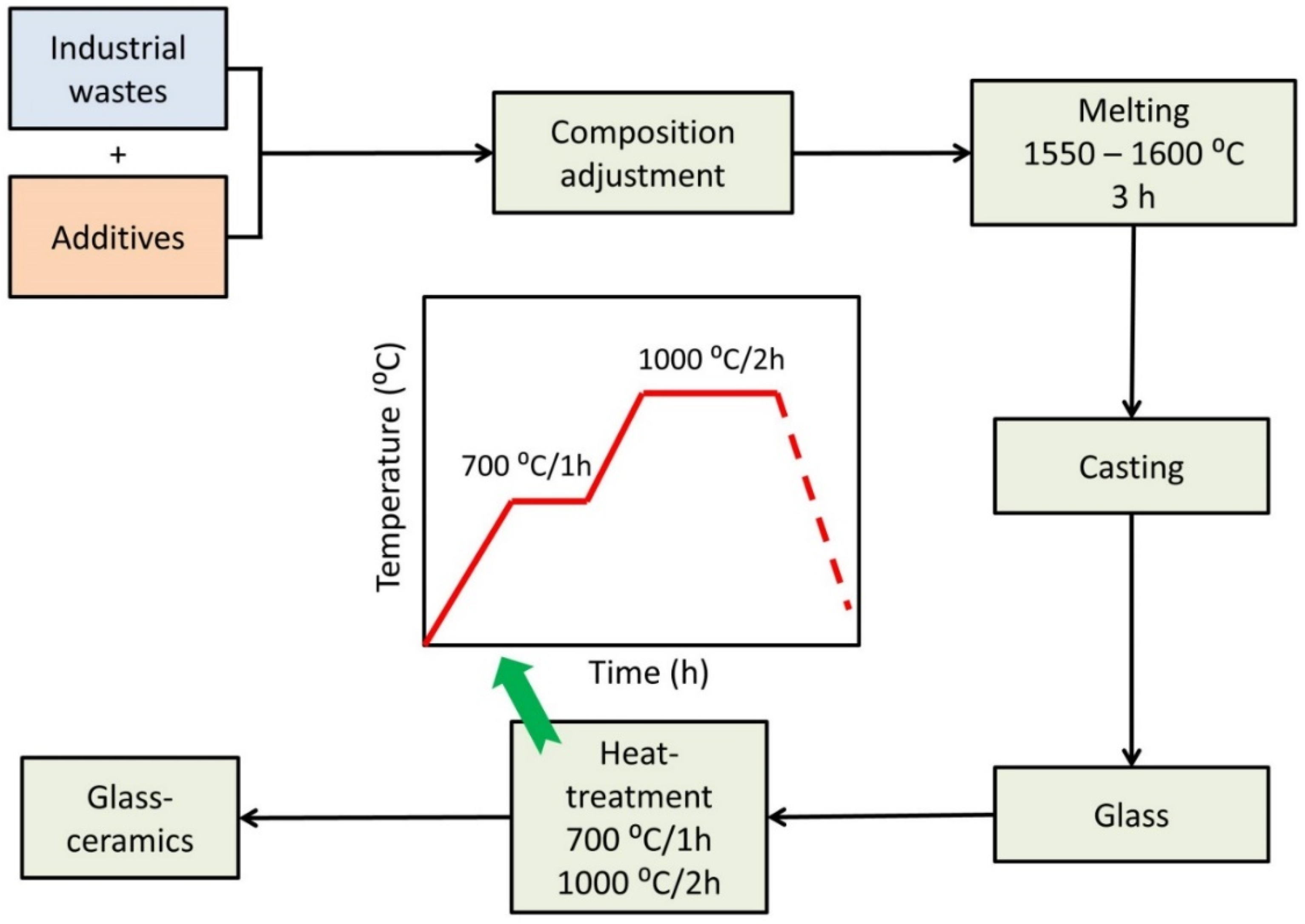

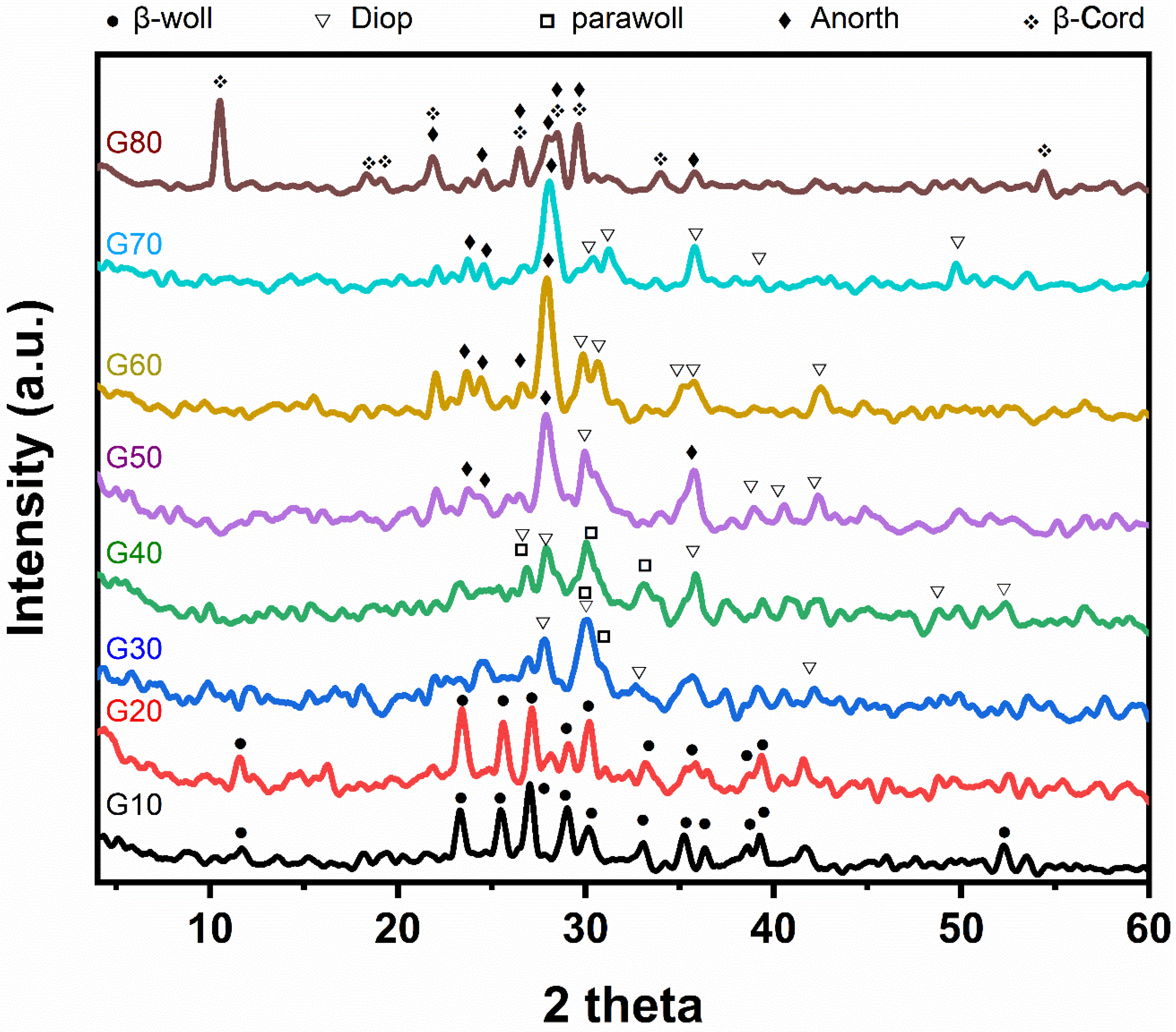

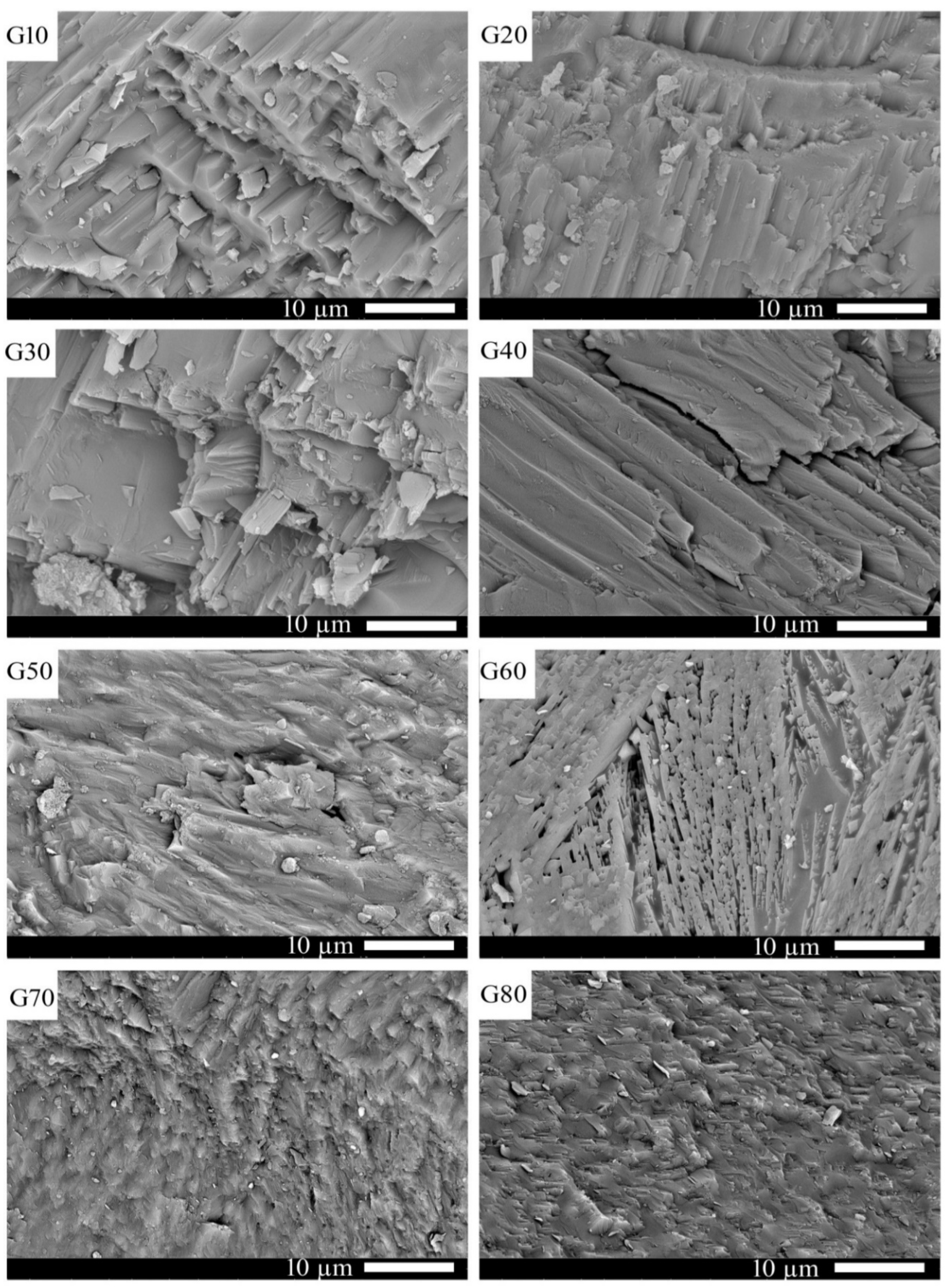
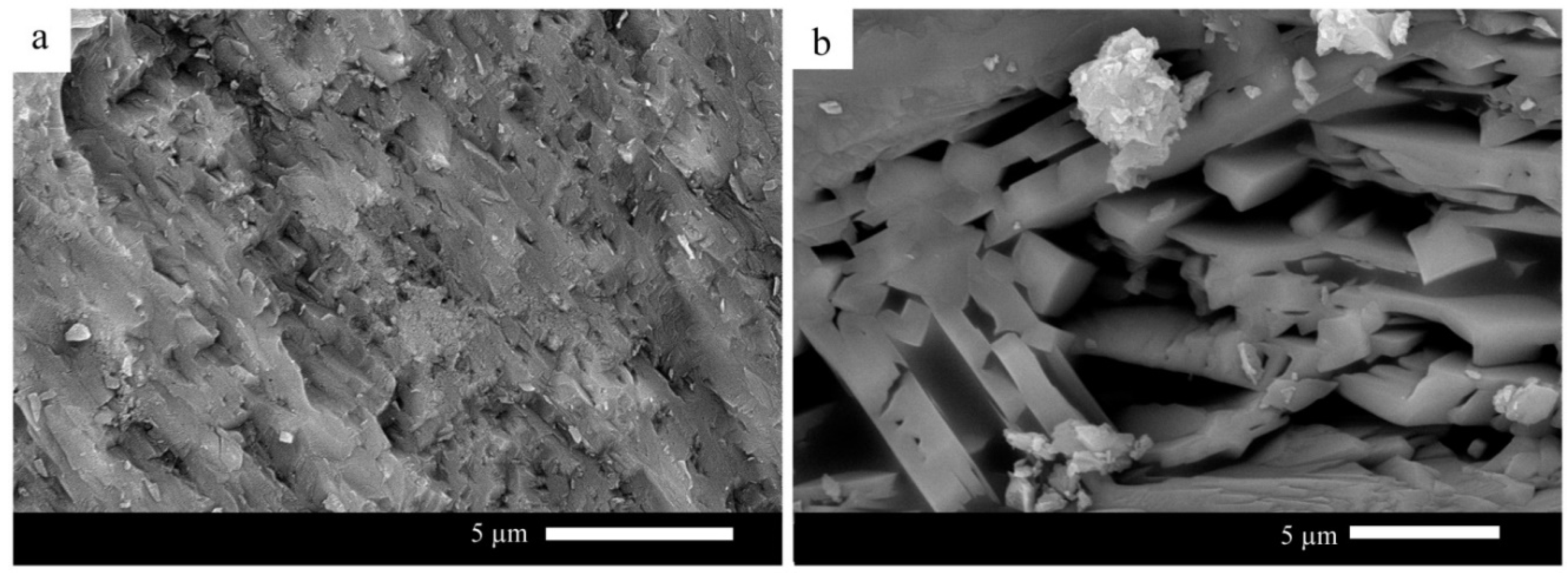
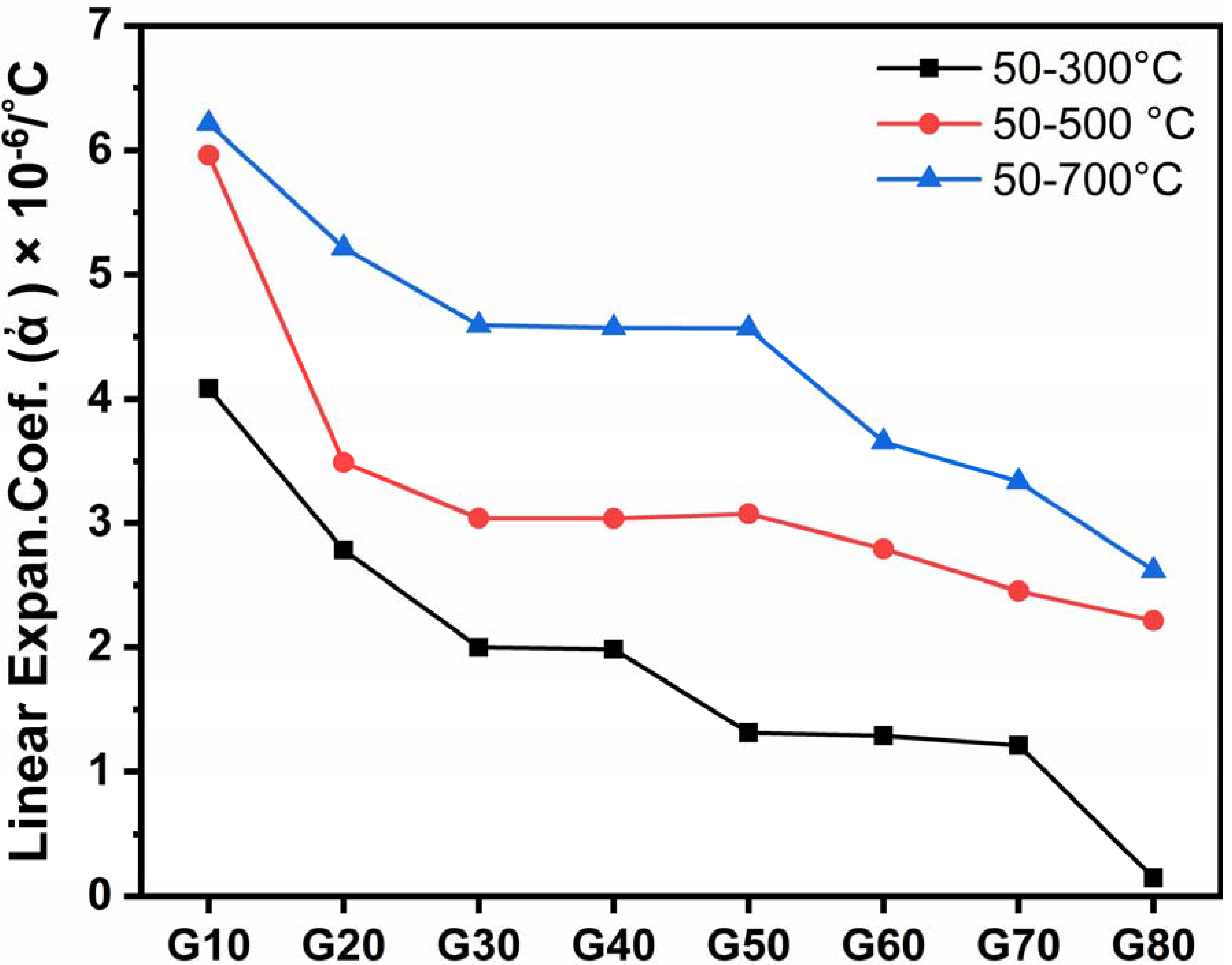
| Oxide wt % | Magnesite (Al-Nasr Mining Co.) | Silica Sand Abu-Zenima (Sinai) | Kaolin El-Tih (Sinai) | By-Pass Cement |
|---|---|---|---|---|
| SiO2 | 0.54 | 99.20 | 44.20 | 6.12 |
| Al2O3 | 1.02 | 0.28 | 37.75 | 2.58 |
| Fe2O3 | 0.48 | 0.03 | 0.93 | 3.37 |
| TiO2 | trace | trace | 1.85 | 0.21 |
| CaO | 6.31 | 0.10 | 0.82 | 55.96 |
| MgO | 40.35 | trace | 0.52 | 0.84 |
| Na2O | trace | trace | 1.15 | 0.29 |
| K2O | trace | trace | 0.72 | 0.73 |
| LOI at 1000 °C | 50.98 | 0.40 | 13.01 | 25.11 |
| Glas No. | Nominal Phase * Composition (wt%) | Oxide wt% | Batch Ingredients (wt%) | ||||||
|---|---|---|---|---|---|---|---|---|---|
| SiO2 | Al2O3 | CaO | MgO | By-Pass | Mag. | Kaolin | Sand | ||
| G10 | 10%cord. + 90% wol. | 51.68 | 3.49 | 43.45 | 1.38 | 60.2 | 1.4 | 3.21 | 35.19 |
| G20 | 20%cord. + 80% wol. | 51.65 | 6.97 | 38.62 | 2.76 | 53.19 | 4.15 | 11.11 | 31.54 |
| G30 | 30%cord. + 70% wol. | 51.61 | 10.46 | 33.8 | 4.13 | 46.29 | 6.87 | 18.95 | 27.9 |
| G40 | 40%cord. + 60% wol. | 51.57 | 13.95 | 28.97 | 5.51 | 39.43 | 9.57 | 26.68 | 24.31 |
| G50 | 50%cord. + 50% wol. | 51.54 | 17.43 | 24.14 | 6.89 | 32.63 | 12.22 | 34.28 | 20.87 |
| G60 | 60%cord. + 40% wol. | 51.54 | 20.92 | 19.31 | 8.27 | 25.98 | 14.87 | 41.89 | 17.26 |
| G70 | 70%cord. + 30% wol. | 51.47 | 24.4 | 14.48 | 9.65 | 19.38 | 17.47 | 49.34 | 13.8 |
| G80 | 80%cord. + 20% wol. | 51.43 | 27.89 | 9.66 | 11.02 | 12.84 | 20.29 | 56.35 | 10.53 |
| Glass No. | Linear Expansion Coefficient (ἀ) × 10−6/°C | Phases Developed | ||
|---|---|---|---|---|
| 50–300 °C | 50–500 °C | 50–700 °C | ||
| G10 | 4.0838 | 5.9616 | 6.2161 | Β-woll. |
| G20 | 2.7820 | 3.4909 | 5.2155 | Β-woll. |
| G30 | 2.0008 | 3.0399 | 4.5930 | Diop. and parawoll. |
| G40 | 1.9857 | 3.0385 | 4.5721 | Parawo. and Diop |
| G50 | 1.3134 | 3.0764 | 4.5671 | An. and Diop |
| G60 | 1.2896 | 2.7932 | 3.6538 | An. and Diop |
| G70 | 1.2126 | 2.4522 | 3.3364 | An. and Diop |
| G80 | 0.1478 | 2.2153 | 2.6181 | Cord. and An. |
Publisher’s Note: MDPI stays neutral with regard to jurisdictional claims in published maps and institutional affiliations. |
© 2022 by the authors. Licensee MDPI, Basel, Switzerland. This article is an open access article distributed under the terms and conditions of the Creative Commons Attribution (CC BY) license (https://creativecommons.org/licenses/by/4.0/).
Share and Cite
Khater, G.A.; El-Kheshen, A.A.; Farag, M.M. Synthesise and Characterization of Cordierite and Wollastonite Glass—Ceramics Derived from Industrial Wastes and Natural Raw Materials. Materials 2022, 15, 3534. https://doi.org/10.3390/ma15103534
Khater GA, El-Kheshen AA, Farag MM. Synthesise and Characterization of Cordierite and Wollastonite Glass—Ceramics Derived from Industrial Wastes and Natural Raw Materials. Materials. 2022; 15(10):3534. https://doi.org/10.3390/ma15103534
Chicago/Turabian StyleKhater, Gamal A., Amany A. El-Kheshen, and Mohammad M. Farag. 2022. "Synthesise and Characterization of Cordierite and Wollastonite Glass—Ceramics Derived from Industrial Wastes and Natural Raw Materials" Materials 15, no. 10: 3534. https://doi.org/10.3390/ma15103534




